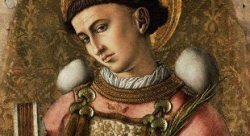(Archdiocese of St. Paul and Minneapolis
By Joseph Michalak
Whenever I tell people I work in the Office of Diaconate, the most common response is “The office of what? Can you spell that?”
And whenever I speak with Serra Clubs or at parishes about the vocation and role of the deacon, the most common question is: “What does a deacon do that a priest or lay person can’t do?”
The response is: That’s the wrong question — at least to begin with. As with any vocation (marriage, religious life, priesthood), we first need to answer “who we are” before we can describe “what we do.”
Christ the servant
In the words of Pope John Paul II and the church documents that govern diaconate formation, the deacon is ordained to “sacramentalize service” and to be an “icon of Christ the servant.” In other words, the deacon is a unique living sacramental sign in our midst of Christ the servant, the one who knows suffering and who pours himself out for the good of others.
Therefore, the deacon is ordained — he is no longer a layman — into Jesus’ own apostolic ministry. In theological terms, the deacon, like priest, stands “in persona Christi capitas” (in the person of Christ the head). But the deacon does so not as victim and priest, but as servant.
As one theologian has put it, a priest presides at the Liturgy of the Eucharist that gives rise to charity; the deacon, however, presides at the “liturgy of charity” that culminates in the mystery of the Eucharist.

(This, by the way, is why the church envisions a normal Mass to be one with a deacon, and it is why you will see after the consecration both deacon and priest holding up the host and the chalice. Here is a more robust sign, so to speak, of the dimensions of Jesus the head of the body, victim-priest and servant laying down his life in love.)
At the end of Mass, it is the deacon’s role to intone “The Mass is ended; go in peace,” and he then is ordained to do precisely that: to lead in extending the sacramental charity of the Eucharist — the apostolic ministry of Christ himself — into the world. The deacon often then goes forth as “icon” of Christ where a priest is unable to go, and the deacon is meant to do so as an “animator of the laity.”
Thus, like laity, the deacon by virtue of baptism shares in the three-fold office of Jesus (prophet, priest, and king). In addition, like bishop and priest, the deacon is ordained into a more specified three-fold participation in the ministry of Christ for the church and the world: ministry of the Word (the foundation), ministry of the Eucharist and liturgy (the heart) and ministry of charity and justice (the expression and fruit). What a deacon does flows from this three-fold ministry.
As a servant of God’s Word, the deacon daily contemplates that Word, especially in Scripture. The deacon always proclaims the Gospel at Mass (even if the pope presides); he evangelizes, teaches, instructs, preaches and leads others into “lectio divina.”
As servant of the Eucharist and the sacramental and liturgical life of the church, the deacon presides at baptisms, assists in the mystery of the Eucharist, is the normal bearer of the Eucharist to the sick and suffering, can witness marriages, bury the dead and preside at benediction.
The deacon commits himself to praying morning and evening prayer on behalf of the church and intercedes as Christ for all. As servant of charity and justice, embodying the eucharistic self-gift, the deacon takes the sacramental presence of the church into the most far-reaching corners of suffering: to the poor, the sick, the imprisoned, the elderly and dying, to immigrants, to the mentally ill, to the estranged — to wherever there is need and suffering.
What does a deacon do? The list is too long to describe fully. But whatever he does, he does as sacramentally ordained into the ministry of Christ the servant; he is icon of that servant, the living bearer of the Word and doer of the Father’s will. That is why the day after Christmas we celebrate the feast of Deacon Stephen, Proto-martyr, who was so perfectly conformed to the Incarnate Word that he died with Jesus’ own words on his lips. And he died as a good servant would: pointing toward and gazing upon his master, Jesus.
Archbishop’s man
Because he is ordained to be a sacrament of service, the deacon is an extension of the bishop’s apostolic ministry; at ordination, only the bishop lays hands on the new deacon, and the deacon promises obedience to the bishop. In the words of an early church father, the deacon is the “eyes, ears, hands” of the bishop, ordained first to serve the diocese and only then a specific parish.
This is why today deacons usually receive a dual assignment, one to assist in a parish setting and one to serve at the archdiocesan level or in some specific ministry such as in a prison, hospital or nursing home, with the police force, with the homeless, at the university or wherever he may be needed.
Often, a deacon can be more aware of specific needs than a priest can be, and the deacon can then bring those to the attention of the archbishop.
With the recent economic downturn, for instance, we have deacons who assist people in dealing with both the material and spiritual effects of foreclosures on their homes.
Although deacons usually serve under the supervision of a priest-pastor, the deacon is not a “mini-priest” — he is both “alongside” the priest as well as “under” the priest, and he often is active in secular settings where a priest is unable to go.
Bridge-builderHere is an especially unique feature of the deacon: he is ordained clergy, but he lives a lay lifestyle. He then is supremely suited to be, and to bring, the sacramental presence of Christ and the church to the world. The majority of deacons (but not all) still work full time in secular employment; the majority of deacons (but not all) are married and have families.
They, therefore, are clergy who know and live with the same kinds of challenges as lay folks. But they are ordained and sent by the bishop to do so even as they live a life of contemplation and prayer and charity and sacramental presence. They then are especially able to activate and assist laity in carrying out their specific apostolic role in professional and political and civic life.
It is noteworthy that the roots of the modern diaconate began during World War II in the Dachau concentration camp as priest-prisoners began praying and thinking about what would be needed for the restoration of culture and civilization in Europe after the war.
Is it indeed possible that the Holy Spirit has ideally suited the deacon (and his wife and family and work) to help rebuild the culture of life and marriage and family that is so under attack today? Many deacons will tell you that some of their most significant ministry takes place at home or at work when not “on duty” but when those around them come to them for prayer or counsel or a listening ear, precisely because they know and see that this is a man of the church.
We recently had a deacon candidate leading others in praying the Liturgy of the Hours at his work simply because others — and not all Catholic — saw him praying and wanted to join in. When we look at the five strategic priorities for the church identified by the U.S. bishops this past year, we see the deacon ideally ready for the New Evangelization.
Pursuit of holinessFinally, because the deacon usually lives as a lay person would, he can be a singular model of the holiness — the self-gift — to which we are all called. He comes from our midst. As he stands at the altar and raises the chalice of suffering, he is offering not only his own self to the Father, but he carries with him the suffering and needs of all those with whom he comes in contact. He knows the injustice; he bears the challenges. He makes the sacrifice of his life for the sake of all.
Who does this — and why?
We are grateful for the more than 200 men from all walks of life who have been ordained a deacon in this archdiocese since 1975. About 140 are still active in official ministry; all are servants in prayer and witness.
For those who are married, their wives and children (and even grandchildren) likewise make an offering of their lives — and certainly of their husbands and fathers.
Many of the wives generously serve in their own right.
And considering that diaconate discernment and formation is at least four years long, at 15 to 20 hours per week, and a deacon then does “official” ministry about 10 hours per week (and the majority often do much more) for no pay and, too often, for little thanks, the question naturally arises: Why do this?
The answer, all will tell you, is simple: love.
Why be a mother or father? Why be a priest? Love. Why be a disciple of Christ? Love — the generous “giving of self,” the dying to self for the good of the other.





































